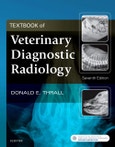- Coverage of ultrasound imaging procedures such as the esophagram, upper GI examination, excretory urography, and cystography helps in determining when and how these procedures are performed in today's practice. - Rewritten chapters on basic interpretation emphasizes radiography, radiation safety, superficial coverage of normal variants, and will include more in-depth information on the framework for interpretation. - An atlas of normal radiographic anatomy in each section makes it easier to recognize abnormal radiographic findings. - High-quality radiographic images clarify key concepts and interpretation principles. - Up-to-date coverage of the most commonly seen species in private veterinary practices and veterinary teaching hospitals includes the cat, dog, and horse. - NEW! Chapter on CT and MR contrast media gives you a better understanding of the agents used to alter patient contrast. - NEW! Information on digital imaging helps you understand the latest advances in digital imaging. - NEW! Chapter on dental radiology covers common dental issues you may encounter in practice. - NEW! Chapter on MR spinal imaging provides the latest information on the diagnosis of spinal cord disease through the use of CT and MRI.
Table of Contents
Section I: Physics and Principles of Interpretation 1. Radiation Protection and Physics of Diagnostic Radiology 2. Digital Radiographic Imaging 3. Physics of Ultrasound Imaging 4. Physics of Computed Tomography and Magnetic Resonance Imaging 5. Radiographic, CT and MR Contrast Media 6. Introduction to Radiographic Interpretation
Section II: The Axial Skeleton: Canine, Feline, and Equine 7. Radiographic Anatomy of the Axial Skeleton 8. Basic Principles of Radiographic Interpretation of the Axial Skeleton 9. The Cranial and Nasal Cavities: Canine and Feline 10. Magnetic Resonance Imaging Features of Brain Disease in Small Animals 11. The Equine Head 12. The Canine and Feline Vertebrae 13. Magnetic Resonance Imaging and Computed Tomography Features of Canine and Feline Spinal Cord Disease
Section III: The Appendicular Skeleton: Canine, Feline, and Equine 14. Radiographic Anatomy of the Appendicular Skeleton 15. Principles of Radiographic Interpretation of the Appendicular Skeleton 16. Orthopedic Diseases of Young and Growing Dogs and Cats 17. Fracture Healing and Complications 18. Radiographic Features of Bone Tumors and Bone Infections 19. Radiographic Signs of Joint Disease in Dogs and Cats 20. The Equine Stifle and Tarsus 21. The Equine Carpus 22. The Equine Metacarpal and Metatarsal Regions 23. The Equine Metacarpophalangeal and Metatarsophalangeal Articulation 24. The Equine Phalanges 25. The Equine Navicular Bone
Section IV: Thoracic Cavity: Canine, Feline, and Equine 26. Principles of Radiographic Interpretation of the Thorax 27. The Pharnyx, Larynx, and Trachea 28. Canine and Feline Esophagus 29. The Thoracic Wall 30. The Diaphragm 31. The Mediastinum 32. The Pleural Space 33. The Heart and Pulmonary Vessels 34. The Canine and Feline Lung 35. The Equine Thorax
Section V: Abdominal Cavity: Canine and Feline 36. Principles of Radiographic Interpretation of the Abdomen 37. The Peritoneal Space 38. The Liver and Spleen 39. The Kidneys and Ureters 40. The Urinary Bladder 41. The Urethra 42. The Prostate Gland 43. The Uterus, Ovaries and Testes 44. The Stomach 45. The Small Bowel 46. The Large Bowel








